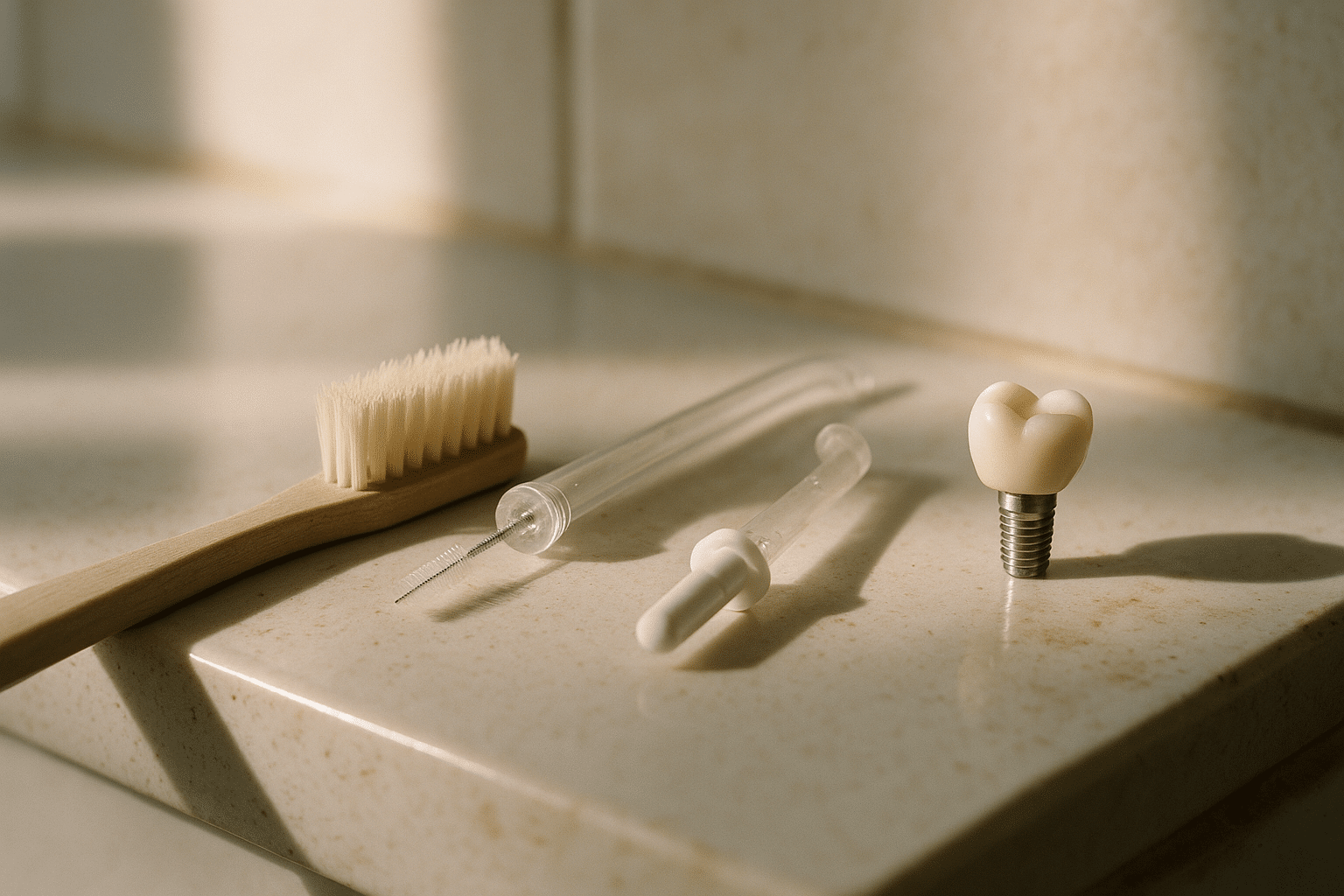
Dental Implants Explained: Benefits, Longevity, and Everyday Care
Outline
We’ll start by clarifying what dental implants are, how they’re placed, and how they differ from bridges and dentures. Then we’ll examine the benefits of dental implants, from confidence in daily life to bone preservation and long-term oral health. Finally, we’ll cover how long implants can last, what affects their longevity, and straightforward daily care strategies to keep them functioning well for years.
Introduction
Few dental treatments blend function, comfort, and aesthetics as effectively as dental implants. For many people, an implant can feel like getting a natural tooth back—stable during meals, discreet in photos, and reassuringly dependable over time. Still, the value of implants isn’t just about appearances. They anchor bite forces, support bone health, and can simplify day-to-day oral care. If you’re weighing your options after a lost or failing tooth, understanding how implants work, their benefits, and how to care for them will help you make a confident, informed decision.
What Are Dental Implants and How Do They Work?
Dental implants are small, biocompatible posts—most commonly titanium or zirconia—surgically placed into the jawbone to act as artificial tooth roots. After placement, the surrounding bone gradually fuses to the implant surface in a process called osseointegration, creating a stable base for a crown, bridge, or denture. In practical terms, this means a well-integrated implant can support everyday chewing and speaking with reliable stability.
Key components
- Implant fixture: The root-like post in the jawbone.
- Abutment: A connector that links the implant to the restoration.
- Restoration: A custom crown, bridge, or denture attached to the abutment.
How the process typically unfolds
- Evaluation: Your dentist or oral surgeon assesses jawbone volume and health using X‑rays or 3D imaging. If bone is insufficient, grafting may be discussed.
- Placement: The implant is placed under local anesthesia. Some cases allow same-day temporary teeth, while others wait for healing.
- Healing: Osseointegration usually takes several weeks to a few months, depending on health factors and jaw location.
- Restoration: A custom crown or prosthesis is fabricated and secured.
Expert perspective
The American Dental Association (ADA) notes that implants are a well-established option for replacing missing teeth when placed and maintained appropriately. The Compendium of Continuing Education in Dentistry reports high survival rates across multiple long-term studies, particularly when patients maintain good oral hygiene and attend regular checkups.
Real-life example
Michael, a recreational cyclist in his 40s, lost a premolar in a sports fall. A single implant let him avoid filing down neighboring teeth for a bridge. He noticed that once healed, chewing felt natural—so natural that he sometimes forgot which tooth was the implant. His story reflects a common outcome: a stable bite and a restoration that blends in.
Alternatives in context
- Fixed bridge: Often quicker, but requires reshaping adjacent teeth. Can be ideal when neighboring teeth already need crowns.
- Removable partial denture: Less invasive initially and more budget friendly, but can move during eating and may require periodic adjustments.
- Implant-supported denture: Uses fewer implants to stabilize a full denture—useful for comfort and chewing confidence.
For a straightforward overview of how implants compare with other options, see this patient guide from Mayo Clinic.
The Benefits of Dental Implants: Function, Health, and Confidence
When people talk about the advantages of dental implants, they often start with comfort and looks—but the benefits go deeper. Because implants are anchored in bone, they transfer chewing forces in a way that can help maintain bone volume around the missing tooth area. This function is a meaningful distinction compared with removable options.
Everyday advantages
- Stable chewing: A secure bite can make eating apples, nuts, and crusty bread more predictable. Many patients report fewer food restrictions compared with removable partials.
- Speech clarity: Implants don’t shift, which can support clear pronunciation, especially in the front teeth region.
- Natural appearance: Custom ceramic crowns are color-matched to neighboring teeth for a seamless smile.
Oral health benefits
- Bone preservation: Mechanical stimulation through the implant can help reduce the rate of bone resorption after tooth loss.
- Tooth-by-tooth solution: A single implant doesn’t require reshaping healthy adjacent teeth, which preserves enamel.
- Gum health potential: With proper care, peri-implant tissues can remain healthy, supporting long-term function.
Research snapshots and expert opinions
- The Cochrane Library has reviewed implant outcomes and highlighted high survival rates for modern systems across multiple trials in appropriate candidates.
- The American Academy of Periodontology notes that implants can offer support for bone and functional stability when maintained with routine care and professional visits.
Quality of life considerations
People often mention confidence as a strong benefit—being able to laugh without worrying about a prosthesis moving, or enjoying meals out without second-guessing the menu. For those with multiple missing teeth, implant-supported overdentures can add stability that traditional dentures sometimes lack. For a practical consumer perspective, see the treatment overview pages on Cleveland Clinic and patient-friendly explanations from Healthline.
Cost and value
Pricing varies by region, case complexity, and materials. Single-tooth implant therapy typically includes the implant, abutment, and crown, while multi-tooth solutions can involve more components. For current pricing snapshots and comparisons, review regional estimates compiled by GoodRx Health and fee ranges summarized by Forbes Health. These resources explain typical ranges and factors that influence cost, helping patients plan realistically and compare quotes.
When implants may not be ideal
- Insufficient bone without grafting: Advanced bone loss may require additional procedures.
- Uncontrolled conditions: Smoking, poorly controlled diabetes, or active gum disease can reduce success rates.
- Bruxism (teeth grinding): Often manageable with night guards, but it’s a risk factor for mechanical complications.
With a thorough consultation and customized plan, many of these challenges can be addressed. That said, realistic expectations and consistent maintenance remain essential for long-term satisfaction.
Lifetime and Care of Dental Implants: What Influences Longevity
With attentive care, many implants remain in service for decades. Longevity depends on a blend of surgical technique, prosthetic design, bite forces, and daily oral hygiene. The restoration on top (crown or denture) may need replacement over time due to normal wear, but the implant fixture itself can be remarkably durable when gums and bone stay healthy.
What affects lifespan
- Oral hygiene: Plaque control is crucial. Peri-implant tissues can become inflamed (peri-implant mucositis) and, if untreated, progress to peri-implantitis, which threatens the bone around the implant.
- Professional maintenance: Routine exams and cleanings help catch early issues. Hygienists may use implant-safe instruments to avoid scratching titanium or zirconia surfaces.
- Bite alignment: Excessive load from grinding or an imbalanced bite can loosen screws or chip ceramic. Night guards and occlusal adjustments help.
- Systemic health: Tobacco use and uncontrolled metabolic conditions can compromise healing and long-term tissue health.
Daily care checklist
- Brush twice daily with a soft toothbrush; electric brushes can be helpful.
- Clean between the implant and neighbors using floss designed for implants, interdental brushes with nylon-coated wires, or water flossers.
- Rinse with an alcohol-free mouthwash if recommended by your dentist.
- Schedule professional checkups every 3–6 months, especially during the first year after restoration.
- Wear a night guard if you clench or grind.
Evidence and expert guidance
- The American Academy of Periodontology on implant care emphasizes plaque control and professional maintenance to reduce peri-implant disease risk.
- ADA clinical resources discuss risk factors such as smoking and diabetes that dentists assess before and after implant therapy.
Troubleshooting common issues
- Tender gums or bleeding: Often indicates inflammation—step up home care and book a cleaning.
- Clicking or movement: Could be a loose abutment screw or worn component; contact your dentist promptly.
- Chipped crown: Usually repairable or replaceable without disturbing the implant.
Comparison table: Implant vs. Bridge vs. Partial Denture
| Aspect | Dental Implant | Fixed Bridge | Removable Partial Denture |
|---|---|---|---|
| Tooth preparation | None for neighbors | Requires reshaping adjacent teeth | None |
| Bone preservation | Helps stimulate bone | No direct stimulation | No direct stimulation |
| Stability while chewing | High | High | Moderate |
| Removability | Fixed | Fixed | Removable |
| Hygiene routine | Brush/floss like a tooth; special tools | Threader/floss under bridge | Clean prosthesis and gums separately |
| Typical maintenance | Checkups; possible crown repairs | Potential replacement over time | Relines and clasp adjustments |
| Aesthetics potential | Excellent blend-in | Excellent when well-made | Varies; clasps may show |
| Upfront cost | Higher per tooth | Moderate | Lower |
Action plan for long-term success
- Get a comprehensive exam and discuss your medical history.
- Confirm a maintenance schedule tailored to your risk profile.
- Invest in the right home-care tools and learn proper technique.
- Protect your restoration with a night guard if you grind.
- Stay alert to changes—early attention preserves long-term function.
For practical maintenance guidance, see the patient care sections from Colgate Oral Care and the clinician-backed tips at Delta Dental.
FAQs
Frequently Asked Questions
Do dental implants set off airport metal detectors?
No. Implants are small and typically do not trigger detectors.
Can I whiten an implant crown?
Whitening gels do not change the color of ceramic. If you plan to whiten natural teeth, do so before the crown is shade-matched.
How long does the whole process take?
From placement to final crown, timelines range from a few weeks to several months, depending on healing, bone quality, and whether grafting is needed.
Are implants painful?
Placement is done under anesthesia. Post-operative discomfort is usually manageable with over-the-counter pain relief as directed by your provider.
What if I smoke?
Smoking is a known risk factor for complications. Discuss cessation support and tailored maintenance with your dentist.
Is zirconia better than titanium?
Both materials are widely used. Titanium has an extensive track record; zirconia offers a metal-free alternative. Your provider can recommend based on your case.
Will insurance cover implants?
Coverage varies. Some plans contribute to parts of the procedure or the crown. Check your policy and ask the clinic for a predetermination.
How do I clean under an implant-supported bridge?
Use super floss or threaders to access under the pontic area, or a water flosser as instructed by your dentist.
Conclusion
Dental implants offer a dependable way to restore missing teeth with a natural look and feel, while supporting bone health and everyday confidence. Their longevity hinges on thoughtful planning, precise placement, and consistent care. If you’re considering an implant, start with a comprehensive evaluation, compare your options, and commit to a simple maintenance routine. The combination of professional oversight and good daily habits can keep your implant working comfortably for years.


